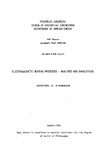JavaScript is disabled for your browser. Some features of this site may not work without it.
| dc.contributor.advisor | Newborough, M. | |
| dc.contributor.author | Calay, Rajnish Kaur | |
| dc.date.accessioned | 2016-04-29T13:16:18Z | |
| dc.date.available | 2016-04-29T13:16:18Z | |
| dc.date.issued | 1994-08 | |
| dc.identifier.uri | http://dspace.lib.cranfield.ac.uk/handle/1826/9846 | |
| dc.description.abstract | Electromagnetic heating (EMH) processes are being increasingly used in the industrial and domestic sectors, yet they receive relatively little attention in the thermal engineering domain. Time-temperature characteristics in EMH are qualitatively different from those in conventional heating techniques due to the additional parameters (viz dielectric properties of the material, size and shape of the product and process frequency). From a unified theory perspective, a multi-purpose model has been developed in order to obtain the heating characteristics for an arbitrary processing situation. Theoretical analyses of various EMH processes in materials of various regular geometries and a range of physical properties have been undertaken. Despite the wide spread usage of microwave energy in the food engineering sector. few understand microwaves and their interactions with foods. Much of the published research is largely focussed from the view point of an electrical engineer and aimed at the oven designer. However, trial-and-error methods are usually employed when developing microwavable food products and when using microwave ovens. The presented thesis is focussed from the view-point of the thermal engineer and aimed primarily at food developers and end users. The multi-purpose model was then modified specifically for simulating the heating of food materials in a microwave oven. The validity of the commonly made assumptions was investigated; in particular the variation of dielectriC properties during the heating processes and their likely influence on the model's predictions. Experimental data available in the literature were compiled and analysed to form a set of equations for predicting the dielectric properties of various food materials. Also available correlations for thermal properties were evaluated for a selected set of experimental data of different food materials. Analyses were undertaken to demonstrate and evaluate the effects of various parameters on the heating characteristics of different food materials commonly heated/cooked in microwave ovens. A qualitative comparison of model predictions and experimental measurements is provided to validate the physical basis of the model. Findings from the model lead to a better understanding of the interactions between foods and microwaves. [...cont.] | en_UK |
| dc.language.iso | en | en_UK |
| dc.publisher | Cranfield University | en_UK |
| dc.rights | © Cranfield University, 1994. All rights reserved. No part of this publication may be reproduced without the written permission of the copyright holder. | en_UK |
| dc.title | Electromagnetic heating processes: analysis and simulations | en_UK |
| dc.type | Thesis or dissertation | en_UK |
| dc.type.qualificationlevel | Doctoral | en_UK |
| dc.type.qualificationname | PhD | en_UK |
